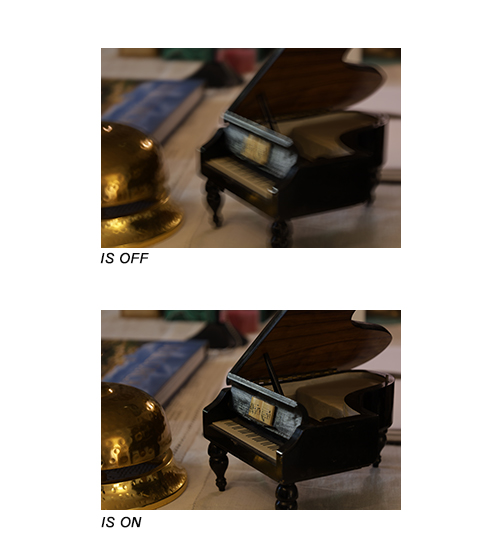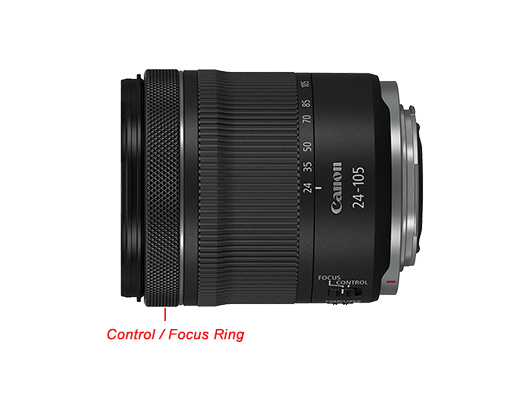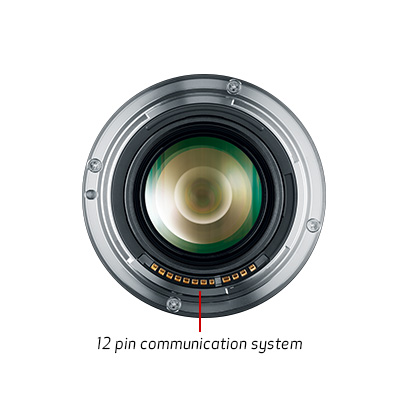Explore null | Canon Latin America

RF 24-105mm f/4-7.1 IS STM
- RF 24-105mm f/4-7.1 IS STM
- Lens Cap E-6711
- Lens Dust Cap RF
-
OVERVIEW
-
SPECIFICATIONS
-
ACCESSORIES
-
RESOURCES
-
SUPPORT
-
MISCELLANEOUS
Perfect for landscapes, portraits, travel and more, the RF24-105mm F4-7.1 IS STM is a compact, lightweight lens for EOS R Series cameras, offering a versatile zoom range* that captures different subjects with ease. For macro enthusiasts, the RF24-105mm F4-7.1 IS STM is particularly advantageous, featuring an impressive maximum magnification of 0.5x using Center Macro Focus – helping you snap photos from as close as one inch away. Your images and videos will remain clear and steady, too, thanks to a leadscrew-type STM motor that enables smooth autofocusing, and optical image stabilization with up to 5 stops** of shake correction. And, with a control ring that allows for quick setting changes***, including shutter speed and aperture, the RF24-105mm F4-7.1 IS STM lens puts quality, convenience and control in your hands.
Compact and Lightweight
A dramatically compact lens, the RF 24-105mm f/4-7.1 IS STM packs a broad zoom range and a bright maximum aperture into a well-balanced, refined design that balances comfortably on EOS R series cameras. The RF 24-105mm f/4-7.1 IS STM lens makes for a lightweight and comfortable, all-day lens.

Ideal Zoom Range for All-day Photography
With a zoom range covering macro-like, wide angle, normal and telephoto, the RF 24-105mm f/4-7.1 IS STM excels in a variety of shooting situations, offering amazing versatility with the turn of a zoom ring. For example, with the RF 24-105mm f/4-7.1 IS STM, the EOS R series cameras can go from shooting landscapes to portraits without a single lens change.

With a minimum focusing distance of 0.66 ft./0.20m and a maximum magnification of approx. 0.4x, the RF 24-105mm f/4-7.1 IS STM lens is capable of capturing detailed images from various distances. Whether you're shooting portraits or still-life, the RF 24-105mm f/4-7.1 IS STM lens can easily provide sharp images with minimal distortion.
The RF 24-105mm f/4-7.1 IS STM lens is ideal for capturing a variety of subjects at a close ratio. With its maximum magnification ratio of 0.5x - using Center Macro Focus. Simply switch the focus mode to "MF" (Manual Focus) on any EOS R series camera, set the focus/control ring switch to "FOCUS" and enjoy snapping shots from as close as one inch away.

The RF 24-105mm f/4-7.1 IS STM lens is designed to work in conjunction with EOS R series cameras, with both the camera and the lens sharing data to dramatically reduce camera-shake blur, regardless of the situation, whether shooting video or stills. With up to 5 stops** of stabilization, it delivers impressively clear results.

Capture fast-moving subjects without missing a moment by combining the leadscrew-type STM with the EOS R series' Dual Pixel autofocus system to achieve high-speed, high-precision focus.
The RF 24-105mm f/4-7.1 IS STM lens incorporates a control ring on the lens barrel that can directly adjust numerous settings including shutter speed, aperture, exposure compensation and more. Located towards the front of the lens, the control ring has a tactile, easily distinguished surface that provides tangible feedback for confident use while looking through the viewfinder.

High-speed Communication with an EOS R Series Camera
Designed to quickly process data, the RF 24-105mm f/4-7.1 IS STM features a 12 pin communication system that is the fastest yet for a Canon lens/camera combination. This accelerates AF, Image Stabilization, the Digital Lens Optimizer and more, helping to simplify complex operations and provide a quick and reliable user experience.
Lens Information Display
Another helpful feature, the EOS R series cameras can display lens information right in the viewfinder, making it easy to confirm the lens's focal length without looking away from the subject at hand.
In-camera Digital Lens Optimizer
The EOS R system's 12 pin communication system enables the Digital Lens Optimizer, which works in-camera to combat aberrations and image deterioration, especially in the edges of the image frame when shooting at a large aperture. Data from the RF 24-105mm f/4-7.1 IS STM lens is transferred automatically to the camera body, facilitating near immediate correction for clear, detailed images.

* In order to use this lens with the EOS R or EOS RP, you must download and install the latest camera firmware from the Canon website.
** Based on CIPA (Camera & Imaging Products Association) standards. Testing performed at a focal length of 105mm using the EOS R camera.
*** The Control ring is the same as the Focusing ring.
| Focal Length Maximum Aperture | 24-105mm, F/4-7.1 |
| Lens Construction | 13 Elements In 11 Groups |
| Closest Focusing Distance | During AF: 0.7 - 1.12 Ft./ 0.2 - 0.34m During MF: 0.43 - 1.12 Ft./ 0.13 - 0.34m |
| Filter Size | Ø67mm |
* In order to use this lens with the EOS R or EOS RP, you must download and install the latest camera firmware from the Canon website.
** Based on CIPA (Camera & Imaging Products Association) standards. Testing performed at a focal length of 105mm using the EOS R camera.
*** The Control ring is the same as the Focusing ring.

Lens Cap E-67 II
The Lens Cap E-67 II is newly designed and fits Canon EF lenses with a 67mm filter size. It helps protect the front glass from dust and scratches.
- Windows Server 2025
- macOS 15
- macOS 14
- macOS 13
- Windows 11
- macOS 12
- Windows Server 2022
- macOS 11
- Linux MIPS
- Linux ARM
- macOS 11.0
- macOS 10.15
- macOS v10.13
- macOS v10.14
- Windows Server 2019 (x64)
- macOS v10.14
- macOS v10.13
- Windows Server 2016 (x64)
- macOS v10.12
- Linux 64bit
- Linux 32bit
- OS X v10.11
- Windows 10
- Windows 10 (x64)
- OS X v10.10
- Windows Server 2012 R2 (x64)
- OS X v10.9
- Windows 8.1 (x64)
- Windows 8.1
- Windows Server 2012 (x64)
- Windows 8
- Windows 8 (x64)
- Windows 7
- Windows 7 (x64)
- Windows Vista
- Windows Vista (x64)
- Windows XP
- Windows XP (x64)
- Windows Server 2008
- Windows Server 2008 (x64)
- Windows Server 2008 R2 (x64)
- Windows Server 2003
- Windows Server 2003 (x64)
- Windows Server 2003 R2
- Windows Server 2003 R2 (x64)
- Windows 2000
- Windows NT
- Windows 3.1
- Windows Me
- Windows 98
- Windows 95
- Mac OS X v10.8
- Mac OS X v10.7
- Mac OS X v10.6
- Mac OS X v10.5
- Mac OS X v10.4
- Mac OS X v10.3
- Mac OS X v10.2
- Mac OS X v10.1
- Mac OS X
- Mac OS 9
- Mac OS 8
- Linux (x64)
- Linux (x32)
- Linux
- Not Applicable
Locating and Installing Your Download Cómo Localizar e Instalar su Descarga Localizando e Instalando seu Download
How to identify your OS version
To help determine which Windows operating system is running on your computer, please view the below steps:
Windows 11
Click on the Windows button (located left to the Search at the bottom).
Click on the Settings button to navigate to the system settings.
Scroll to the bottom of the page and click on the About button.
You will be able to find your Windows operating system under the Windows Specifications section.
Windows® 10
Click Start or click the Windows button (usually found in the lower-left corner of your screen).
Click Settings.
Click About (which is usually located within the lower left of the screen). The next screen should display the Windows version.
Windows 8 or Windows 8.1
Option1: Swipe in from the upper-right corner of the screen while viewing the desktop in order to open the menu, then select Settings.
Select PC Info. Under Windows edition, the Windows version is shown.
Option 2: From the Start Screen
While on the Start screen, type computer.
Right-click on the computer icon. If using touch, press and hold on the computer icon.
Click or tap Properties. Under Windows edition, the Windows version is shown.
Windows 7
Click Start or click the Windows button (usually found in the lower-left corner of your screen).
Right-click Computer and select Properties from the menu. The resulting screen should now display the Windows version.
Linux
To check the version of your Linux operating system (OS), you can use the following commands in your terminal:
1. uname -r: Displays your Linux kernel version.
2. cat /etc/os-release: Displays your distribution name and version.
3. lsb_release -a: Displays specific details about your Linux distribution and version.
4. You can also use the hostnamectl command to display the Linux kernel version. However, this command is only available on Linux distributions that use systemd by default.
To help determine which Mac operating system is running on your computer, select the Apple menu in the upper-left corner of your screen and choose About This Mac.
Upon selecting, you should see the macOS name followed by the version number.
Canon U.S.A Inc. All Rights Reserved. Reproduction in whole or part without permission is prohibited.